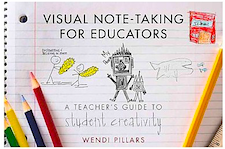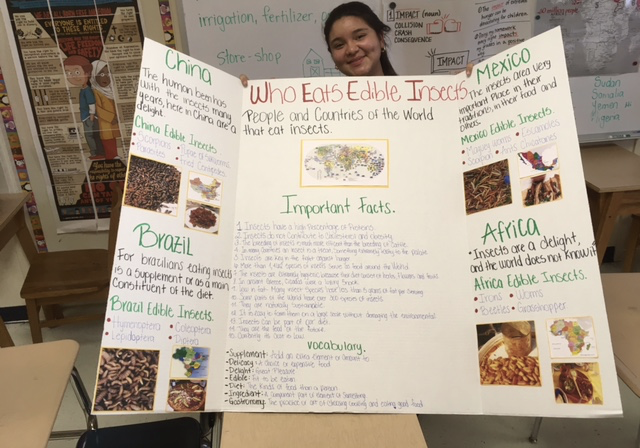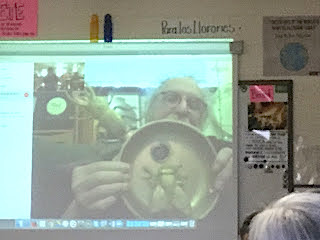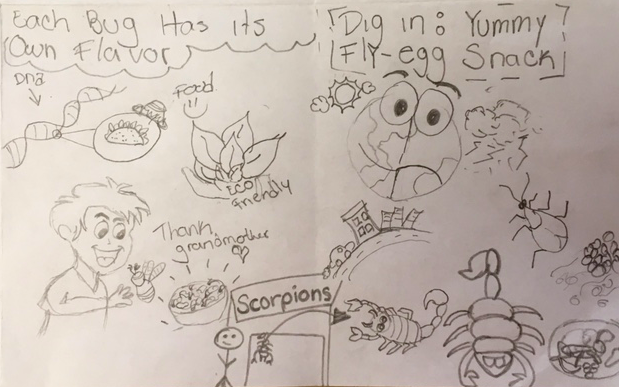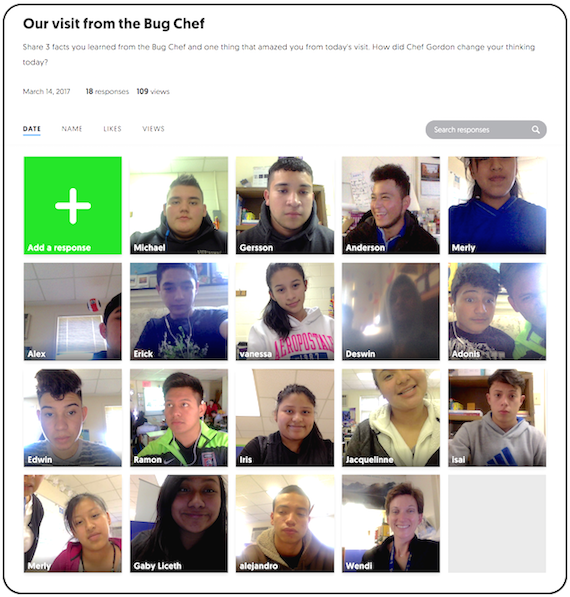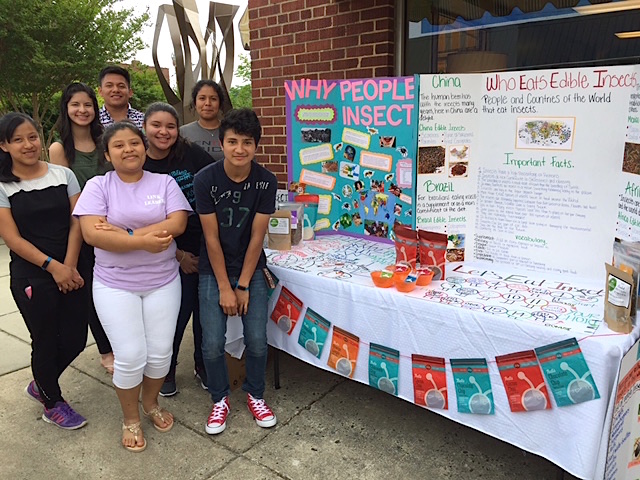Edible Bugs! Wendi Pillar’s Engaging ELL Unit
ELL teacher Wendi Pillars, author of the popular book Visual Notetaking for Educators, leads us through a unit sure to supply high engagement for adolescent learners.
Each semester I get to write new units and curricula for our English Language Learners, and since many students are in my class multiple times, I’m constantly seeking new topics to tie our literacy skills together.
This semester our focus came from United Nations Sustainable Goal #2, Zero Hunger. We began by using excerpts from the United Nations Food and Agricultural Organization report on Future Prospects for Food and Feed Security and the book Edible Bugs (Reading A-Z) as our base texts. We have also drawn on interactive transcripts from a handful of TED Talks, UNICEF resources, and help from folks who are raising insects for consumption.
It’s been a semester with plenty of crunch!
Sustainable ways to feed the world
As part of our exploration of Zero Hunger, my unit plan called for my ELL students to examine sustainable agriculture and foods, including edible insects. Entomophagy may be a long word for “eating insects” but for 80% of our world’s cultures, it is a way of life – and a perfectly practical choice to hook some adolescent learners as they improve their language skills.
I also anticipated that distinguishing between malnutrition and poor nutrition, and ways that insects might help (or not) alleviate these food challenges, would deepen our learning.
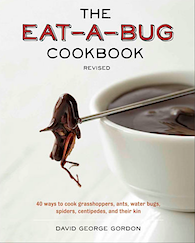
Our semester of delicious fun not only included lots of student research but also opportunities for “authentic learning,” beginning with a taste of what I call “gateway bugs” :-).
Treats like Bitty Foods Chocolate Chirp Cookies, which are made with cricket flour; flavored roasted crickets, and Hotlix candies have helped our students join the 80% of the world’s cultures who eat insects! (Please note I’m not promoting any particular brand. This is just what we tried first.)
As The Bug Chef says: “Bug Appetit!” (Bet you can’t watch this video, “A Feast at the Explorer’s Club,” without a grimace or two. My favorite part is between minutes 3:30-4:30.)
Student videos: Checking for understanding
When working with secondary students, especially those learning English, it’s often a challenge to find authentic audiences. As many of you probably know, it’s certainly a game-changer when it’s not just the teacher who is looking at your work or listening to you speak.
Midway through the unit, as formative assessment and a check for understanding, my students were tasked to create a one-minute video synthesis about what they had learned so far about Edible Insects.
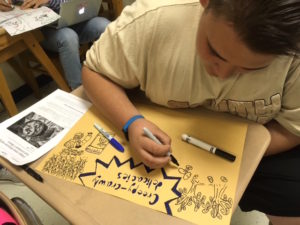
Students then reflected on what makes an interesting video, reflected on what they could add or do differently after watching each others’ videos, and what they liked about their own videos.
Check out the videos below to see how providing this “simple” formative assessment allowed students to express themselves and their learning in very different ways, while collaborating within a time limit. What is most exciting to me is how different each video turned out, a testament to the importance and value of choice and multi-format assessments. And certainly, there are improvements to make, but without an initial prototype, how will you know?
Gaby & Iris: Edible Insects
Also watch:
How can YOU tweak student assessments to include all four domains of speaking, reading, writing, and listening? And who could be your students’ next authentic audience?
Skyping with an expert: The Bug Chef expanded our thinking
It truly does take a village to teach our students. The good news is (for anyone who hasn’t been in a classroom for a few years) inviting guests to talk to our students no longer requires their physical presence in the room.
In our case, we were able to participate in a live conversation with The Bug Chef (he’s famous), who spoke to us via Skype from Seattle, Washington. He was gracious enough to respond to my simple tweet, then we coordinated logistics via email. My students compiled questions in advance, to give him a heads up as to what they were wondering, as well as provide an idea of what they already knew.
Although edible insects are a new concept for many to consider, Chef Gordon has been eating and cooking with bugs for over two decades, and next year will mark the 20th anniversary of his Eat-A-Bug Cookbook. His goal is to teach others to think differently about insects and what you’re eating in general. People have strong feelings about what qualifies as “food,” and so learning about the value of eating insects expands people’s thinking in an era when food demands will grow dramatically.
The Chef credits his parents with expanding his own ideas about food by taking him to restaurants featuring varied cuisine when he was younger. His current favorite insect is the waxworm. “Kind of like a grape in sweetness, but when you bake them, they taste more like pistachio nuts.” See? Just like that he expands your concept of what constitutes “food”!
Here’s some of what The Bug Chef taught us
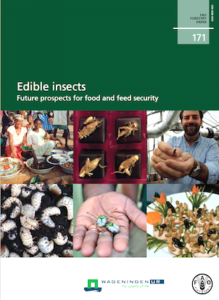
Acquiring insects: One of our students’ questions was how people actually get insects? They are expensive to purchase online, as we have learned, so how do people in other countries afford them? Some people farm insects, such as crickets and mealworms, which is considered more sustainable, but these tend to be in countries where eating insects is still a novelty (like the USA). There are even pollutant-free crickets for those so inclined, although most of the farmed insects seem to be organic. (Mealworms, by the way, are not worms, but baby beetles.)
Most insects are wild-harvested, which means people (kids included!) simply go out and catch their insects. We learned that some students bring their cricket catch to school in Thailand, where they are sauteed en masse for lunch. You bring ’em and the school cook will make ’em tasty. Talk about a fresh catch. Wild-harvested insects are the greater norm, but there is a potential for over-harvesting, and so this method runs the risk of not being sustainable, given the population surges ahead.
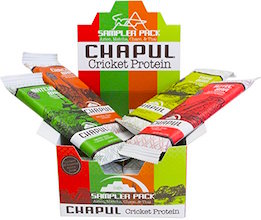
Other products like earthworm jerky can also contain protein. Many insects have high levels of proteins, vitamins, amino acids, and antioxidants, so it might behoove us to reconsider our fears of “icky bugs.” Chef Gordon prefers whole insects and would rather people eat them in a near natural state of wholeness in order to realize that they actually taste good. From a man who has won a Gold Frying Pan Award in a cooking competition, that sounds like sage advice.
Preparation & Safety: Chef Gordon prefers eating his bugs whole but he does suggest cooking them to ensure safety. There are parasites and possible diseases, but for the most part, insects are safe to eat. Even scorpion venom, he says, is made primarily of proteins, so when they are cooked (if the poison gland is not cut off), the proteins which cause allergic reactions are denatured in the cooking process, leaving nothing to worry about. Scorpions actually have “tasty white meat,” he says. So no excuses – time to give yet another “white meat” a try.
Career Readiness: Imagine the new careers in the food industries. Farming, raising, marketing, and creating new snacks! Immigrants have brought new cuisines to our country since America was founded, so bringing in insect dishes isn’t really so new if it’s en vogue for 1.9 billion people in the world today.
I used Flipgrid to gather quick responses to Chef Gordon’s presentation. Using Flipgrid as a formative assessment tool provides immediate information for me to work with as I determine follow-up instruction, while easily integrating an authentic audience for their speaking.
Our first insect feast
As we continued through our exploration of whether insects are the food of the future, of course our students harbored a mix of wonder and disgust about how insects actually taste.
Although nowhere near the size, amount, or kind of insects that many people eat on a regular basis, we tried our hand at crickets. It was a first for all of us, including myself and my partner in crime, Ms. Jimenez.
Have a look. And remember that, although we are having fun because it is a novelty (and a choice!) for us, it’s not the case for many others in the world.
(If you find yourself intrigued by this lesson idea, a great place to start might be by looking at what Americans already eat – the insect parts that the FDA actually permits in our foods! Skim the Commodities and Defect Action Levels table here.)
A festive culminating activity
My students culminated their Entomophagy unit with an information table during a recent downtown festival. It provided others with a “taste” of their learning, literally and figuratively, and again, provided a truly authentic audience, from little kids to senior citizens.
One of the students created a board game so that we could entice more festival-goers to try our insect hors d’oeuvres. Students spoke with people of all ages, and we learned there is a lot of curiosity around entomophagy in our town!
When asked about whether insects are a viable food of the future, every single student (including those who totally nixed the idea of eating insects on the first day of our unit), believed that yes, insects could be a possible solution to alleviate future food challenge issues and possibly even world hunger.
Their supporting evidence included the array of insect nutrients, their sustainable growing features, and the fact that they actually “taste good” as just a few of the reasons why we should look at insects in a new light.
Several of my students, when they see bugs at school now – including the biology classroom’s Madagascar Hissing Cockroaches or any one of springtime’s flurry of flying insects – will say, “Hey, Ms. P, we could eat those!” And more than a handful have told me they’re ready to try eating a tarantula or scorpion.
That’s what I love most about learning. Shifting mindsets with information. To take a topic that no one knows about, and use it to transform even our most basic beliefs of what we consider “food.” This was a great experience. Pass the bugs, please!
Download Wendi’s list of ideas and resources for this unit
_______________
